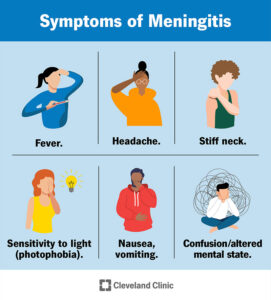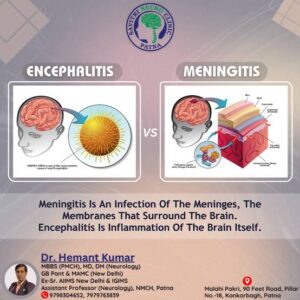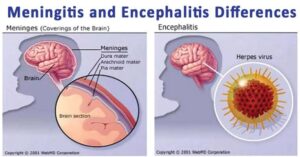Back to: MICROBIOLOGY 300 LEVEL
Welcome to class!
You’re welcome back, and I’m truly glad you’re here. Today’s lesson is about two life-threatening infections that affect the brain: bacterial meningitis and encephalitis. These illnesses can come on very suddenly, especially in our part of the world where dry seasons and overcrowding can make outbreaks more likely. Knowing how these conditions work, how to spot them, and how to respond quickly can mean the difference between life and death. As a microbiology student in Nigeria, this knowledge is not just academic—it’s vital.
Bacterial Meningitis, Encephalitis
Bacterial Meningitis
This is an infection of the meninges—the protective membranes covering the brain and spinal cord. It is most often caused by bacteria like Neisseria meningitidis, Streptococcus pneumoniae, and Haemophilus influenzae.

Transmission:
It spreads through respiratory droplets—from coughing, sneezing, or close contact with an infected person. This is why outbreaks are common in schools, dormitories, or IDP camps.
Symptoms:
High fever
Severe headache
Stiff neck
Sensitivity to light
Nausea or vomiting
Confusion or difficulty staying awake
In babies, you might notice a bulging soft spot, poor feeding, or constant crying.
Diagnosis and Treatment:
Diagnosis is confirmed through a lumbar puncture to test cerebrospinal fluid. Treatment must begin immediately with intravenous antibiotics such as ceftriaxone or penicillin.
Complications:
Without quick treatment, it can lead to brain damage, hearing loss, or death within hours.
Imagine a teenage boy in Yobe who complains of a stiff neck and high fever during the dry season. He’s rushed to the hospital where a doctor recognises the signs of meningitis and starts immediate treatment—his life is saved.
Encephalitis
This is an inflammation of the brain tissue itself, usually caused by a viral infection, though bacteria, parasites, or autoimmune reactions can also be responsible.

Common Causes:
Viruses like herpes simplex virus (HSV), measles, or mumps. In rare cases, it may follow a bacterial infection or occur during malaria.
Symptoms:
Fever and headache
Seizures
Behavioural changes like confusion or irritability
Muscle weakness or paralysis
Drowsiness, and in severe cases, coma
Diagnosis and Treatment:
Diagnosis includes brain scans, lumbar puncture, and sometimes EEG. Treatment depends on the cause—antivirals like acyclovir for HSV, or supportive care if the cause is unknown.
Complications:
Can cause long-term neurological issues like memory loss, speech problems, or even permanent disability.

Think of a child in Makurdi who begins acting confused and has seizures following a bout of measles. At the hospital, doctors suspect viral encephalitis and begin supportive treatment, which helps control the swelling in the brain and prevent lasting damage.
Summary
- Bacterial meningitis affects the brain’s protective layers and progresses very quickly.
- Encephalitis is inflammation of the brain tissue, mostly caused by viruses.
- Both are medical emergencies that require urgent hospital care.
- Early diagnosis and prompt treatment are key to preventing complications or death.
- Vaccination, good hygiene, and public health awareness help prevent these diseases.
Evaluation
- What part of the brain does meningitis affect?
- List three symptoms that are common to both meningitis and encephalitis.
- Why is it important to treat bacterial meningitis urgently?
You’re not just learning—you’re equipping yourself with life-saving knowledge. The kind of wisdom you’re building today could help protect a village, a school, or even an entire region. Stay focused and curious—Afrilearn is proud to be part of your learning journey. See you in the next lesson!
